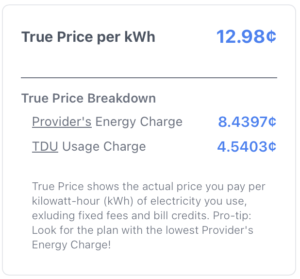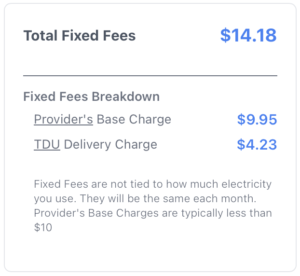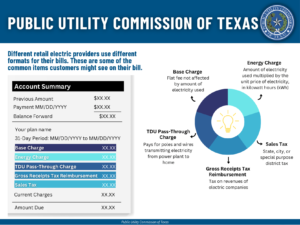Smart Electricity Shopping: Master the Texas Energy Market
Knowledge is power! Put the Power in your hands, and avoid overpaying for electricity!
We pride ourselves on helping customers become smart electricity shoppers. It’s what we were born to do!
On this page, we gathered some of our most insightful tips to help you become a savvy shopper and avoid the pitfalls of choosing a costly plan when shopping for electricity in Texas. Our goal is for you to avoid finding yourself in a bad electricity plan again – no more surprise electricity bills or overpaying for electricity when you use Texas Electricity Finder!
The electricity market in Texas can seem overwhelming and confusing, but if you break it down, it’s easy to save and avoid the pitfalls of bad electricity plans. Use these valuable insider tips to master the Texas electricity market.

What we'll cover
Insider Tips
Know your usage!
Many electricity plans boast low prices but require special conditions or modifiers to receive them. Almost all those conditions or modifiers are based on how much electricity you use. The two most common modifiers are Bill Credits and Time of Use plans.
While these plans can lead to substantial savings, they are tailored for customers with specific usage patterns. Understanding your energy usage is the key to unlocking these savings. See more about these Plan Modifiers below.
How to estimate your usage range
Check your February and August electric bills. The usage of those two bills will give you a good idea of your electricity usage range for the year. February should be at the low end of the range, while August will be at the high end.
How to use your usage range
Knowing your usage range is great for plans with Bill Credits, e.g., $50 credit if you use 1000 kWh.
First, to take advantage of plans with a bill credit, the difference in your usage range needs to be less than 500 kWh, meaning the difference between the low and high end of the range should be no more than 500 kWh. Anything beyond this, and you’ll be overpaying compared to a plan without a bill credit.
Second, the low end of your range has to be at least the Bill Credit trigger amount. In this example, the low end of your range needs to be at or above 1000 kWh. If it’s not, for the months your usage is below 1000 kWh, even if it’s 999 kWh, you will be paying significantly more than the advertised price.
What impacts your usage
Your HVAC system has the biggest impact on your electricity usage. Newer, more efficient systems can greatly reduce your electricity usage.
Electric Heaters consume a lot of electricity, resulting in higher consumption during the winter. Gas heaters use very little electricity, significantly reducing the amount of electricity used during winter. If you have an electric heater, your electricity usage will be more consistent throughout the year. With a gas heater, your electricity usage will vary much more between the summer and winter months.
- Other major impacts on usage:
- • Washer/Dryer – Electric washers and dryers often consume large amounts of electricity.
- • LED Lighting – Although the impact is small per bulb, the more lights you have on at once, the more electricity you save when using LED lights.
- • Windows – Older windows are often less efficient at maintaining house temperatures, which results in higher electricity usage.
- • Blinds/Shades – Keeping shades and blinds closed during the hot summer months helps reduce electricity usage and maintain house temperatures.
- • Fans – Fans are a good way to keep air circulating and help maintain temperatures, and they use much less electricity than your HVAC system.
Provider's Charges
Retail Electricity Providers (REPs) buy wholesale electricity and resell it directly to customers. They resell it by creating electricity plans for customers to choose from. Knowing and understanding the provider’s charges in these plans is very important. It’s the single biggest differentiator between these plans and various providers.
- In our Electricity Plan Pricing Guide, we explain how electricity plans cover the purchase of electricity from the provider, and also the delivery and maintenance by your local TDU.
- TDU charges are the same for everyone. Whereas, the provider’s charges are unique per plan and provider.
- In the details section of our plan cards, we break out the charges so you can see the Provider’s charges versus the TDU charges.
For straightforward, no-gimmick plans, we recommended finding the plan with the lowest “Provider’s Energy Charge” and “Provider’s Base Charge”
- • Provider’s Energy Charge – Purchase price of electricity from that provider. The amount you pay them per kilowatt-hour (kWh) of electricity you use.
- • Providers Base Charge – Fixed monthly fee regardless of the amount of electricity you use. Not all plans have them, but for the ones that do, they’re generally between $5 and $10.
- These usage charges are not to be confused with the ‘Advertised Price.’ The usage/energy charge is the price you pay for kWh before any discounts or credits are applied. The ‘Advertised Price’ includes credits, discounts, etc., and averages them over a specific kWh usage.
Pro Tip: A $10 base charge equals roughly 1¢ per kWh in the plan price. So a 13¢ per kWh price with a $10 base charge would be essentially the same as a 14¢ plan with a $0 base charge at 1000 kWh.
Plan Modifiers
- Two of the most common modifiers are Bill Credits and Time of Use. These can actually work in your favor if used wisely. The key is knowing your usage.
 Bill Credit means you’ll receive a credit on your bill if you use a certain amount of electricity. But If you don’t use at least the amount of electricity that triggers the credit or exceed that trigger amount by more than 400-500 kWh, you will end up overpaying.
Bill Credit means you’ll receive a credit on your bill if you use a certain amount of electricity. But If you don’t use at least the amount of electricity that triggers the credit or exceed that trigger amount by more than 400-500 kWh, you will end up overpaying.  Time of Use plans offer discounted energy pricing during specific times of the day. Providers assume a certain percentage of electricity is being used during a specific timeframe, e.g., 30% of your electricity is used between 11 p.m. and 5 a.m. They use this assumption to come up with their advertised price.
Time of Use plans offer discounted energy pricing during specific times of the day. Providers assume a certain percentage of electricity is being used during a specific timeframe, e.g., 30% of your electricity is used between 11 p.m. and 5 a.m. They use this assumption to come up with their advertised price. - To truly benefit from Bill Credit plans, your usage must consistently fall within a 400-500 kWh range of the trigger usage amount. For Time of Use plans, your usage needs to fall in line with the assumptions made by the provider to benefit from the savings.
- Most customers don’t use a consistent amount of electricity throughout the year. Your usage may fall within that range for a month or two, but you’ll be overpaying in other months when it doesn’t.
It’s crucial to understand the details about any electricity plans, particularly those with modifiers or conditions to receive the advertised price. Ensure these conditions align with your usage patterns before making a decision.
Term
One of the most overlooked details in an electricity plan is the term. Don’t do it, it could cost you!
First, pay close attention to when the plan expires. Short-term plans are notorious for eye-catching low rates, especially if they expire during peak summer months, which means you’ll renew when rates are at their highest.
At Texas Electricity Finder, we show you the number of months in the plan’s term and the month it expires so you can quickly see when you’ll be up for renewal.
Second, don’t get stuck in really long plans just because you don’t like shopping for electricity. Locking yourself in for 36 months just to avoid having to shop for electricity is a bad plan. Long-term plans have their place, and if you’re getting into a really long-term plan, e.g., more than 24 months, just make sure it’s for the right reasons and not avoid shopping for electricity.
Texans can save up to
$500 per year
- by switching to a new electricity plan
- explore affordable plans in your area
Know your rights as a customer
It’s important to know and understand your rights as a customer if you get into a dispute or need to file a complaint with your electricity provider.
The Public Utility Commission of Texas (PUCT) provides relevant information regarding your rights as a customer when it comes to disputes, service refusal and disconnects with your electricity provider.
- Here you can find information on following topics :
- • Refusal of Service – This covers the reasons an electric provider can and cannot refuse service to a customer.
- • Disconnection of Electric Service – This goes over the reason an electric provider disconnects service, with and without a notice.
If an issue cannot be resolved with your electricity provider, it’s recommended a complaint be filed with the Public Utility Commission of Texas (PUCT), which can be done here.
Understanding Charges on your Electric Bill
At Texas Electricity Finder, we provide all the tools necessary to be a smart shopper and help you find the best electricity plans in Texas!
Even though our focus is helping you shop for electricity, we also want to answer some of the more common questions after you sign up for electricity and recieve your first electric bill.
The Public Utility Commission of Texas (PUCT) is a great resource for information regarding charges on your electric bill, but here we want to cover some of the most common items found on your electric bill.
- Here are some of the charges we cover extensively on Texas Electricity Finder:
- • Base Charge – A flat fee applied each month regardless of the amount of kilowatt (kWh) used.
- • Energy Charge – A charge based on the electric energy (kWh) consumed.
- • TDU Delivery Charges – Charge to cover the cost of moving electricity from the generation plant to your home, also known as “TDU Pass-Through Charges”
- Here are other common charges you may see:
- • Demand Charge – A charge based on the rate at which electric energy is delivered to or by a system at a given instant, or averaged over a designed period, during the billing cycle.
- • Changes in Rates – Any change in the customer’s rates or charges due to the variable rate feature of the Terms of Service contract.
- • City Sales Tax – Sales tax collected by authorized taxing authorities, such as the state, cities, and special purpose districts.
- • PUC Assessment – A fee assessed to recover the statutory fee for administering the Public Utility Regulatory Act.
- • Miscellaneous Gross Receipts Tax Reimbursement – A fee assessed to recover he miscellaneous gross receipts tax imposed on retail electric providers operating in an incorporated city or town having a population of more than 1000.
- For a complete list, visit the PUCT website.
Other Helpful Tools
We’ve created some help pages to help you become a smart electricity shopper. Our goal is for you to avoid bad plays and overpaying for electricity. Many plans available today are confusing, and if you don’t know what to look for, you could end up in a bad situation.
- Electricity Plan Pricing Guide – Shopping for a new electricity plan can be confusing, but it doesn’t have to be. Here, we’ll explain how electricity plan pricing works in simple and easy-to-understand terms. Knowing how electricity plan pricing works will give you an edge and newfound confidence when shopping for a new electricity plan.
- True Price – Discover our True Price! A tool designed to simplify your choices and empower you to find the perfect plan.
- Plan Cards – No more surprises on your electric bill! Our plan cards are designed to help you make informed decisions and find the perfect plan for your needs.
- Electricity Facts Label – Dive into the Electricity Facts Label. Where we cover what they are, how to read them, and how to use them to your advantage.
- Utility Suppliers (TDU) – Your local utility supplier plays a key role in keeping the lights on. Learn more and find your Utility Supplier.
- If you found this helpful and think others could also benefit from reading it, share it!




